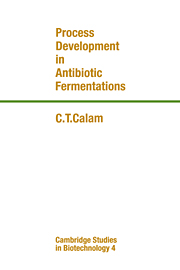Book contents
- Frontmatter
- Contents
- Preface
- Part 1 Background
- Part 2 Process development in the laboratory
- Part 3 Industrial fermentation plants and pilot plants
- 11 Fermentation plants and pilot plants
- 12 Process development in the fermentation plant
- 13 Two plant problems: infection and variations in the level of production
- Postscript
- Bibliography
- References
- Index
12 - Process development in the fermentation plant
Published online by Cambridge University Press: 05 February 2012
- Frontmatter
- Contents
- Preface
- Part 1 Background
- Part 2 Process development in the laboratory
- Part 3 Industrial fermentation plants and pilot plants
- 11 Fermentation plants and pilot plants
- 12 Process development in the fermentation plant
- 13 Two plant problems: infection and variations in the level of production
- Postscript
- Bibliography
- References
- Index
Summary
Introduction
Development work in the plant is needed for a number of reasons. These may be the need to introduce a new process developed in the laboratory, the need to improve existing plant processes and to correct faults, and the need to deal with problems like infection. Constant attention is needed to hold an existing high standard of working, as results may drift downwards over a long period. There may be times when it is desired to reduce the rate of production, temporarily, and an economical process may be needed to make this possible. The two serious problems that sometimes arise, infection and yield fluctuation, are discussed in Chapter 13, where methods for the study of plant batches are also considered.
This subject has been discussed in a number of papers, for example Queener & Swartz (1979), Küenzi & Auden (1983), and in general by Vandamme (1984). These accounts tend to stress the difficulty and complexity of the subject. This is often the case, especially with highly developed processes. In the earlier stages this is often less difficult. With penicillin, for example, the early processes worked quite well in the plant, though infection and reproducibility presented greater problems. Often the initial difficulty is to get good growth in the inoculum; this difficulty can be overcome after a certain amount of experimentation. As the process is developed, problems such as those described in Chapters 5 and 6 become more apparent. As production increases and the steps in progress become less, the critical factors become more important, and experimental work becomes more difficult to interpret.
- Type
- Chapter
- Information
- Process Development in Antibiotic Fermentations , pp. 174 - 180Publisher: Cambridge University PressPrint publication year: 1987

